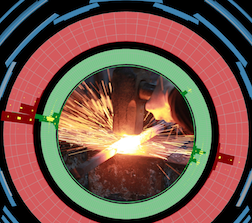Speaker
Description
Our group studied the low-lying hadron spectrum of lattice QCD on a large $32^3 \times 256$
anisotropic space-time lattice at a near-physical pion mass of $240$ MeV.
Quark fields were smeared using a
Laplacian Heaviside kernel which is later exploited to estimate quark
propagation with a novel method: the Dirac matrix-inverse is stochastically
estimated by introducing noise vectors in the Laplacian Heaviside subspace.
Interpolating operators expected to overlap
with single- and two-particle meson and baryon states were used,
staying below the three-particle energy threshold.
Preliminary results for the $I = 1, S = 0, T_{1 u}^+$ channel
will be shown, along with other channels.
The Luescher method has been applied to the two-particle finite-volume
spectrum to obtain results for the phase shift and width
of the $\rho$. Future work will briefly be discussed, which includes
an alternative to the Luescher method involving an effective finite-volume
Hamiltonian to fit the spectrum, and the implementation of tetraquark operators
with fundamental (and higher) gauge-links.
Summary
This talk will be showing methods used by our group for studying hadron resonances with lattice QCD. Our preliminary results with a $32^3 \times 256$ anisotropic lattice will be shown, which includes the finite-volume spectrum in multiple channels and the $\rho$ scattering phase shift. Additionally, I will discuss future plans for alternatives to the Luescher method and for implementing tetraquarks.
